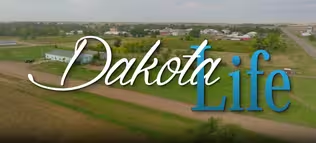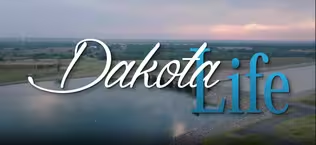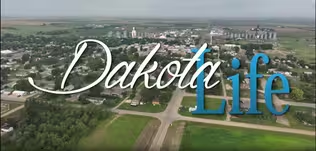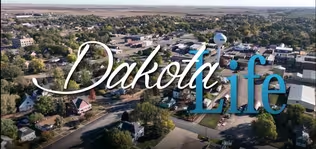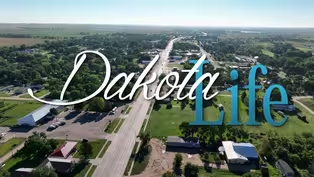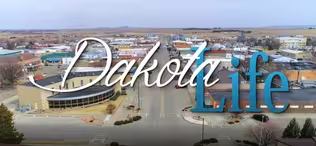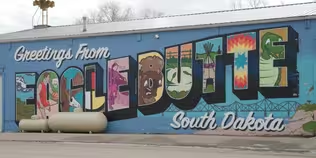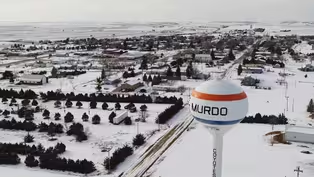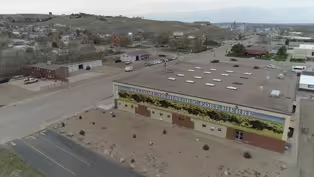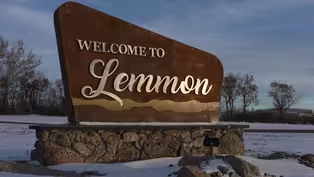Dakota Life
Greetings from Mobridge
Season 24 Episode 3 | 28m 15sVideo has Closed Captions
Greetings from Mobridge
We tour the Scherr-Howe Event Center home to 10 murals from renowned artist Oscar Howe. Recall the fall of 1989, when Mobridge residents had to dig themselves out of a massive tumbleweed invasion. We find out that a man’s best friend can also be their best helper. We take a ride on the Potter County bookmobile and learn how the Mobridge-Pollock School District is bridging cultural divides.
Problems playing video? | Closed Captioning Feedback
Problems playing video? | Closed Captioning Feedback
Dakota Life is a local public television program presented by SDPB
Support Dakota Life with a gift to the Friends of Public Broadcasting
Dakota Life
Greetings from Mobridge
Season 24 Episode 3 | 28m 15sVideo has Closed Captions
We tour the Scherr-Howe Event Center home to 10 murals from renowned artist Oscar Howe. Recall the fall of 1989, when Mobridge residents had to dig themselves out of a massive tumbleweed invasion. We find out that a man’s best friend can also be their best helper. We take a ride on the Potter County bookmobile and learn how the Mobridge-Pollock School District is bridging cultural divides.
Problems playing video? | Closed Captioning Feedback
How to Watch Dakota Life
Dakota Life is available to stream on pbs.org and the free PBS App, available on iPhone, Apple TV, Android TV, Android smartphones, Amazon Fire TV, Amazon Fire Tablet, Roku, Samsung Smart TV, and Vizio.
Providing Support for PBS.org
Learn Moreabout PBS online sponsorshipMore from This Collection
Dakota Life stories from towns in central South Dakota
Video has Closed Captions
In the heart of the Standing Rock Indian Reservation, we discover McLaughlin. (29m 29s)
Video has Closed Captions
We travel to Burke and introduce you to a writer, an artist, and the twins of Franklin Street. (29m 50s)
Video has Closed Captions
Timber Lake celebrates its heritage in July with the Days of 1910 activities. (29m 41s)
Video has Closed Captions
Uplifting culture of the Dakota Oyate on the Crow Creek Reservation. (29m 17s)
Video has Closed Captions
Onida is home to a ranching family, a salmon fisherman, and a memorabilia collection. (27m 18s)
Video has Closed Captions
Dakota Life travels to the community of Mission. (29m 34s)
Video has Closed Captions
Winner has great baseball, theatre, and local authors and is a sportsperson's paradise. (27m 25s)
Video has Closed Captions
Dakota Life visits the community of Eagle Butte (26m 58s)
Video has Closed Captions
Fort Pierre is our host community this month for Dakota Life. (28m 36s)
Providing Support for PBS.org
Learn Moreabout PBS online sponsorship(upbeat music) - [Announcer] This is a production of South Dakota Public Broadcasting.
(upbeat music) - The reason Mobridge is Mobridge is right there in the name.
The town is the site, the Milwaukee Railroad chose to cross the Missouri River.
Legend has it that the name was an abbreviation used by Telegraph operators at the construction site.
Missouri or Mo and Bridge and it eventually stuck.
20 years prior to building the bridge, General SE Olson on a hunting expedition to the area was convinced that this would be the best spot to cross the Missouri, just south of the confluence with the Grand River.
He wanted it to be known as Grand Crossing and then from the west bank, the Milwaukee road could make tracks all the way to the Pacific.
Although time passed after Olson's recommendation, the site worn out over others like Everett and Lebow, but a section of Highway 12 that runs through town is still called Grand Crossing, after the General's suggestion.
- So, welcome to Dakota Life and greetings from Mobridge.
(upbeat music) - [Announcer] This program is made possible with your support and with a gift from Regional Hospital and Clinics in Mobridge.
- Construction on the Railroad Bridge began in 1906 with thousands of workers streaming into Mobridge.
First, a temporary wooden bridge was built with a permanent steel bridge completed in early 1908.
The Milwaukee Railroad built a roundhouse in Mobridge with 28 stalls, but the community never grew into the rail hub Boomtown that some had envisioned.
Options for transportation were changing and a river crossing for car traffic was ready in 1924.
The U.S. Army Corps of Engineers replaced that original bridge in 1961.
It was part of the Oahe Dam project.
Lake Oahe filled the gulches and the gullies and in the end, the crossing here may be even more grand than General Olson could have imagined.
And the fishing isn't bad either, you see over time, the identity of Mobridge gradually shifted emphasis a little more towards the Mo in Mobridge, but the bridges are as important as ever as functional and aesthetic infrastructure.
This part of South Dakota is a Panorama of rolling bluffs surrounding the Bridge City, and it's long inspired local and regional artists.
There's a wealth of public art on display, indoors and out and at rivals larger cities, from murals by Dell Iron Cloud to sculptures by John Lopez.
Coming up on our visit to Mobridge we're going to meet a team of trained cow dogs who help manage cattle on a 10,000 acre ranch.
We'll take you back to 1989 when the residents had to dig out of a massive tumbleweed invasion and we'll learn how cross-cultural engagement and understanding is taking place in the community.
Plus we'll take a detour down the informational byway on a bookmobile.
First, let's stop at the Scherr Howe Arena it's code name for a pair of Olympic wrestlers and a Dakota artist destined for greatness.
(vocalizing music) - It's got a life of its own, you know, it's, you don't even have to know what the history, you know, a stranger can walk in here on vacation from Connecticut and they can be in here and just be in awe of everything that it shows.
And it does it's history on these walls and everything in here is priceless.
- [Narrator] From its classic look to its historical murals.
The Scherr Howe Arena in Mobridge is one of the more iconic sports venues in the State.
(organ music) The Scherr Howe Arena and Auditorium was built in the 1930s as part of a works progress administration project.
Now more than eight decades later, the reputation and magnitude of the building still exists.
- It was a hallowed hall of sports, but I think to someone that doesn't know the place, the first thing they're going to see is these beautiful, all these murals on the wall.
And they're going to want to know the history of that.
And so, you know, it goes in two directions for what it has.
So if I was making the description it might be kind of hard because the most important things to me and to most people are the things that happened when I was 16, 17, 18 years old, that happened to me in here.
And that was with me and my fellow sports fans and fellow athletes.
- [Narrator] The priceless murals on the wall were painted by legendary native American painter, Oscar Howe in 1942, prior to his service in the Second World War.
- I think that, you know, the artist, Oscar Howe he was from Crow Creek Reservation, and this is really one of the first you know times when he really developed his skills and portrayed them here so this is very historically important display of his work.
From his upbringing, you know, he was able to capture the essence of a Dakota culture here.
I myself I knew Oscar Howe, he was artist in residence at the Over Museum and Vermilion when I was a student there in the 70s and I used to like to visit him.
He was not really a talkative person though (laughs) he was not talkative because, you know, he didn't really need to speak a lot because he shared everything, everything about himself and it's right here.
It's right here because he had all this information, all this feeling within himself.
- [Narrator] Oscar Howe's legacy of the murals is still part of the namesake of Mobridges old-school arena.
The other part of the building name comes from local wrestling legends, Jim and Bill Scherr.
The twin brothers would go on and compete in the 1988 Olympics.
- Neither of them ever forgot their roots in Mobridge.
They have uncles and aunts that still lives here.
They have cousins that still live here.
Bill married a local girl, okay.
Their families are still here, but they come back all the time.
But even when they were in college they would come back and they would, I would turn and practice with them, yeah.
I would say, "Hey, what'd you guys learn?
"Show us what we need to be doing."
And so they would come back and that became a tradition that all of our graduating seniors would come back.
- [Narrator] In 2010, high school sporting events move to a new gymnasium at the new Mobridge High School.
But the Scherr Howe Arena still stands to this day.
It's now both an athletic and cultural symbol with memories that will stand the test of time.
- It is a museum you know it's got historic art and you know perhaps the most important thing about it now, because it's the part of its originality, you know, it came with it when it was new but it's also a part of the present and the gym floor, the baskets it's you know that that's a part of the past.
- In 2014, the Oscar Howe murals here at the Sherr Howe Arena were restored through a joint effort of the South Dakota Arts council and the National Endowment for the arts.
Another great but lesser known lady of American artists from the area is, Ambrose Shields.
A talented versatile painter who alternates between native American, pastoral and Western themes.
We've got more about Ambrose Shields for you at sdpb.org/dakotalife.
Western themes are all around the Mobridge area.
Before the Railroad Bridge the Missouri ferry operators orchestrated massive cattle crossings.
And though the days of the open range were already past legendary outfits like the diamond day and the Matador Land and Cattle Company still ran a enormous herds.
As the Railroads enter the cattle ferry business passenger trains brought homesteaders who hastened the change already underway on the Dakota range, but make no mistake this is cattle country.
And to help Mobridge area ranch manager, David Dagley relies on a ranch hands best friend.
It's a rare breed of trained cow dogs.
They help him manage cattle on the AC Land and cattle ranch.
- Away to me.
- [Narrator] That's Mobridge rancher, David Dagley, moving a group of bulls with his cow dog, Annie.
Before the AC Land and cattle manager enlisted Annie's help.
The cowboy says moving cattle used to be quite a chore.
- Oftentimes if we wanted to have two or three people at least on Four Wheeler or horseback.
There were times I didn't have very much help.
And I was out there trying to move a few hundred head of cattle all by myself and just trying to be everywhere at once and just having a hard time.
- [Narrator] Annie is a Hangin' Tree Cowdog, trained by David to move cattle based on voice commands and hand signals.
- I was quickly amazed with the working drive that she had and her ability to work long range and independently.
- [Narrator] The AC Land and Cattle Ranch covers more than 10,000 acres.
And to best manage the native grasslands for forage to feed the more than 500 head of cattle he is responsible for, David implements rotational grazing practices.
This means moving cattle about every two to three days during the growing season.
- Get ahead, good girl, get ahead.
- So I use a lot of commands on my dogs I mean, probably 20 or more.
If you've got your cattle as the center of the clock when I say come by, the dog's supposed to circle clockwise around the cattle or if I'll say say, a way to me, I want the dog to be circling counterclockwise.
- [Narrator] Annie became David's number one ranch hand four years ago.
- What started out as looking for ranch help turned into raising cow dogs of her own.
So, I've trained a number of Hangin' Tree Cowdog.
- [Narrator] Starting when a puppy is about two months old training a Cowdog is a daily task.
It takes about five months before the puppies are ready to be introduced to small livestock.
The Dagley cow dogs are introduced to cattle as early as nine months.
When it comes to raising and training cow dogs, David has plenty of help.
His wife, Susanna and their three homeschooled children; Hadassa, Clementine and Ephraim all pitch in.
- Feeling it, it's fun and I like feeling like I can get stuff done like move the cows all by myself.
- [Narrator] Clementine is 12, and she is responsible for puppy chores, daily feedings and keeping their pen clean.
Clementine and her younger brother Ephraim help with cow dog training.
The siblings and their dad also train their cows dogs to compete.
Their sister Hadasa and mom Susanna do not compete, but they help the others get ready for competitions.
It's a process that mom Susanna enjoys.
- I learned just enough to know a lot harder than it looks.
And so it's amazing for me to watch how David can communicate with the dogs and he can just work with a team, with them and it's like having tried it I know that he just has a special gift for that and it's amazing for me to watch him and the kids do that.
- [Narrator] During the competition cow dogs and their trainer are judged on how well they move a group of cattle through the course.
The course is designed to highlight many tasks.
The Dagley's cow dogs are expected to accomplish during a typical ranch workday, like penning cattle, guarding a gate, running them through a gate and loading them onto a trailer.
- These dogs are extremely athletic, they have incredible endurance they can go all day long.
In fact, I can move cattle, tell them that'll do and I have to keep an eye on them sometimes cause they're going to sneak off and want to go right back to work.
- We have more for you about the Dagley family and Hangin Tree Cowdog @sdpb.org.
Now from cow dogs and cattle to cultures.
The Mobridge area is famous for remains of Ancient Erika earth launch sites.
Many were excavated by archeologists from the Smithsonian and other institutions.
After the Arikara, Lakota, and Dakota people migrated to the area.
In 1953, descendants of the legendary Hunkpapa Lakota leaders Sitting Bull argued that his remains should be moved from a burial site near Fort Yates closer to his former camp near the confluence of the Missouri and the Grand Rivers.
Well, the governor of North Dakota didn't agree but a Clandestine mission managed to move Sitting Bull's remains.
And then sculptor Korczak Ziolkowski created a Memorial to the chief.
He used granite from the site of his ongoing work at the Crazy Horse Memorial.
There are contradictory narratives that surround the Memorial and how they reflect on a man who much has been written of, but who in many ways remains an enigma.
What is clear, is that the population of Mobridge is changing and the complexities of history impact relationships to the land and to people.
But in the present community leaders are bridging cultural divides, particularly in the school system.
- There's several reasons why people, you know, our community members from the reservation do end up in Mobridge, you know, whether it's for jobs, housing things like that so we're just continuing to see that happen as our population expands and so, you know, I think that's part of the reason people are starting to see more diversity in our school and they're may be more comfortable coming to school here.
- [Narrator] Tasha Peltier is a tribal member, parent and on the Mobridge-Pollock School Board.
She along with superintendent, Dr. Tim Frederick are advocates for a school environment that serves the needs of a now more racially balanced enrollment.
- Knowing now today that we're, you know, over 40% native American economically disadvantaged is right around the 50%.
I think we have seen a shift in our community.
I think that it's one of the things and I say this in a positive manner, I think that there's potential for growth for families when they're here.
And I also do believe that, you know, as a school district we've, we're doing a better job of embracing the identity of all of our kids.
- [Narrator] That identity means, programs for racial understanding and honoring student achievement according to cultural tradition, some of which are coordinated by the Lakota education committee.
- That's one area where we do, you know, really seek involvement from parents and community members to really make sure that we're meeting the needs of our tribal, you know, our native American students, but also to promote activities that, you know, teach everybody else about some of the things, you know, our culture, our language, we try to do community activities, we try to promote family activities just to enrich the understanding of our students and the families and communities as well.
- [Narrator] Monique Reynolds is a graduate of Mobridge-Pollack and past president of the Lakota Education Committee.
And she has a close family connection to the L.E.C.
- My grandma actually was one that helped start the Lakota Education Committee here.
And they were really active within the school there was more funding then.
So I would say there were some things that were probably better when I was in school actually, versus now, even just because there was more funding.
And I think the community was a little more active.
You know, that's something I think that we've struggled with the Lakota Education Committee a little bit is community involvement.
- [Narrator] But Monique says, she's watched the work of the L.E.C and the school make a difference helping students and not just letting them fail.
- It's the norm here to graduate, it's the norm here to persevere through some of that.
And, you know, there's some normal healthy relationships and things that they can look to and there's, you know, more opportunity there's jobs and stuff like that.
So I feel like we have a lot of strengths in our diversity and I feel like that's going to be one of the things that is going to be able to help us as native people.
- Look through a clear lens you're going to see Native American students with White students, sharing ideas, working together.
I think we have a great opportunity as adults to learn from them.
- Our students do very well, you know, their test scores show it their graduation rates show it and so that's a huge success for us.
- Cultural understanding can grow at any age, but perhaps with the perspective of time, Mobridge will see what the next generation of leaders can bring to the community.
The Klein Museum has an ever-growing collection of cultural and historic heritage from the area.
Photos by Oscar Heuttner documents some of the hardships, as well as the lighter moments from the turn of the century life.
Paintings by local artists, Del Iron Cloud, and Ambrose Shields adorn the walls.
One of the most curious mementos in this vast collection at the Klein have an episode that might sound like a tale from a Western science fiction novel.
In the fall of 1989, Mobridge residents had to dig out of a massive tumbleweed invasion it literally buried the town and attracted national attention to this very unusual storm.
(guitar music) - Area below the Moose Club is called the loose flats.
And it's a very shallow area and when the lakes high, it's really good fishing cause there's a lot of structure and stuff there, that was all bare.
There were 600 acres bare in the Moose Flats and tumbleweeds this all started growing there and nobody thought much of it.
- [Narrator] On the morning of November 8th, 1989, the residents of Mobridge have woke to a blizzard, not of snow, but tumbleweeds.
The previous night brought a powerful wind storm to Mobridge with gusts up to 90 miles an hour and with the strong winds came the tumbleweeds from Moose Flats.
- Yeah, Southwest part of town.
The wind was so powerful it just forced them and as they got caught they packed in between houses and into entryways and a garage between houses and garages and from house to house to house in a block, they were all blocked in.
Well one of the ladies she was (indistinct) woke up in the middle of the night and she thought there was a hailstorm because there's ping Ping was hitting her trailer house.
When she woke up in the morning it's tumbleweeds and they're packed in she can't get out of her trailer house.
- [Narrator] As people attempted to emerge from their homes, they realized just how many tumbleweeds had invaded their community.
- 10th Street and this car is just edging along the edge because 10th Street is covered with tumbleweeds.
The viaduct down here was totally plugged you couldn't drive under the viaduct.
They said a lot of them were like eight feet high, but there was one place they were like stacked 15 feet high.
It was really, really intense.
- [Narrator] So what do you do with 600 acres of tumbleweeds jammed into every cracking crevice of half your town?
You bale them with a round baler.
- I tried crushing them that didn't seem to work some of them just bounced back.
They tried driving over them but they just got caught under things.
I mean with big machinery I'm not talking about cars, I'm talking about big things that didn't work.
So finally, they started baling them and they baled them up into round, those big round bales that weigh about 1200 pounds a piece.
And Willie Hepper was doing it and he used them as a windbreaker at where his cattle were.
- [Narrator] Once the tumbleweeds were cleaned up, baled failed and hauled away, the people of Mobridge could relax a bit and begin to see the humor in what had happened.
- After the real danger was over people decided to take advantage of it and so we made t-shirts that said attack of the tumbleweeds, the bars had drinks that were called Tumbleweed drinks.
And we made the National News.
We made the three major networks, we made Newsweek magazine, we made People magazine, Jay Leno Show, we did a phone interview with him, but I think he made jokes about it.
And one of the ladies said, when he was making jokes about it, it wasn't funny yet (laughs).
So.
- We have more on the Attack of the Tumbleweeds and its aftermath for you at sdpb.org/dakotalife.
Well the winds that scattered tumbleweeds across the country also fueled the imagination of writers like, Willa Cather and Louis L'Amour.
You'll find their tails as well as stories for all ages on the shelves here at the Mobridge Library.
It was built by local developer A. H. Brown in 1929.
If you live a little further out in the country, you can check the schedule of the local bookmobile.
Now this type of wheeled extension to the local library used to be a little more commonplace.
But fortunately, for the residents of nearby Potter County, it still is.
There's still a bus that can deliver Peter Rabbit, Nancy Drew, or Huck Finn to young literary minds.
- [Narrator] When the weather gets cold and wet, the big question about the Potter County free libraries bookmobile is will it start?
(brake lever squeaks) (engine starts) Today the answer is yes.
The bookmobile spends a lot of its time here in Hoven.
It's a town of about 400 people, 25 miles Northeast of the libraries home base in Gettysburg.
Betty Wright says she's been driving the bookmobile for about 25 years.
She was a library board member when the previous driver retired and she was present when the board started looking for a new driver.
- And they looked around the board and said, who knows how to drive a stick shift?
And I said, I do.
And they said, you got the job.
- [Narrator] The old truck was purpose-built in 1963.
It's never been anything but a bookmobile.
There's a little uncertainty about how long it's been serving Potter County but- - This is the bookmobile that I went to when I was in country school.
- [Narrator] Wright remembers that bookmobile day was always a good day back then she says that hasn't changed.
- bookmobile would come and it's just like today.
it's the most exciting day when the bookmobile comes and everybody heads out to pick out books.
- [Narrator] Howe Vanilla Mattery third graders appear to agree.
Mobile libraries got started back East in the horse and buggy days of the 1890s.
There was a regular circuit in South Dakota for this bookmobile in the 1930s and the State Library had one running in the 1950s.
In the 1960s they weren't all that rare.
There are still several bookmobiles operating in South Dakota and regional libraries serving rural community still do what they can to bring books to people wherever they are, especially kids.
- It enables the students not only to get a more variety of authors and book titles but it allows them to get out of the classroom setting, out of the school setting and come into the bookmobile, which brings pleasure to everyone.
Because when everybody sees the bookmobile coming, they get happy.
- [Narrator] Even the youngest kids enjoy a little time in the bookmobile.
These baby bookworms tend to find what they're looking for on the lower shelves.
The middle section is for older kids, the upper shelves are reserved for taller and presumably more mature readers.
Holly Wright loves being the bookmobile lady and loves watching the kids in her community grow up and come back.
- You bet they come back and then they bring their kids back.
- I used to come to the bookmobile when I was in elementary school, yup.
This thing has been around for years it's awesome.
It's we love the bookmobile.
- [Narrator] Old trucks don't run on love alone so Holly Wright says, she's glad there are a couple of good mechanics in town able to keep her on the road.
- Well, I always said, as long as the old girl kept running, I would keep driving it so, you know, she keeps going.
- [Narrator] And she gets to bring books into kids' lives and smiles to their faces.
And besides who else around here knows how to drive a stick shift.
(truck engine roars) - Mobridge is a town of distant horizons for just over the next hill there's a bookmobile, a cattle operation, across Lake Oahe there's the Grand River, Standing Rock Reservation and the Grand River Casino Complex.
Mobridge, isn't lost in this grand panorama.
It's a community that seems bigger than it is on the cusp of something, inviting you to experience the striking natural environment that has inspired some of our state's greatest artists.
There are stories around every corner that have never been given the grand telling they deserve.
For instance, a humble monument in the Mobridge City Park is the only tribute to a brave group of warriors known as the Fool Soldiers.
They risked their lives and their reputations to rescue captives taken during the U S Dakota war in 1862.
They made a brave stand for civilian rights in wartime, nearly 90 years before the Geneva Conventions.
To stand on a hill here and imagine the view as General SE Olson sought or Sitting Bull before him.
It's hard not to imagine untold stories, swelling up from under Lake Oahe and more grand crossings to come.
(guitar strums) You can revisit or share our stories of Mobridge and other communities at sdpb.org/dakotalive.
And thanks for coming along with us to Mobridge I'm Larry Rohrer and for all of us at SDPB, thanks for watching.
(country music)
Support for PBS provided by:
Dakota Life is a local public television program presented by SDPB
Support Dakota Life with a gift to the Friends of Public Broadcasting


